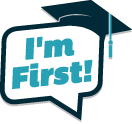This article was originally written for FirstGenerationStudent.com, now a part of ImFirst.org.
Paying for College 101
Did you know that most college students receive some type of financial aid? That’s because financial aid can come in many forms and from many places. In order to receive financial aid, you must apply for it. We’ll talk more about the application process later (see the Applying for Financial Aid page), but first, here’s an overview of the most common types of financial aid:
Grants
Grants are financial aid that you don’t need to pay back. Grants usually come from your state, the federal government and colleges. Many of these grants are based on need, which means that they are based on your (and your family’s) financial circumstances. Maybe, for example, you’ve heard of the Pell Grant, but you’re not sure what it is. The Pell Grant is financial aid from the federal government based on your family income. Your college determines which grants you are eligible for, but if you are eligible for Pell, you would get between $577 and $5,550 for the academic year.
Scholarships
Like grants, scholarships are financial aid you don’t pay back. Scholarships can come from many places including your state government, private organizations like churches or local clubs, and colleges. Sometimes scholarships are based on academic or athletic talent. Other times scholarships may be based on your interest in a specific subject or career. It’s important to remember that many scholarships include a separate application process outside both the regular application process to college and the financial aid application process. For this reason, we discuss scholarships in greater depth here.“You should always take out federal loans before you even consider taking out a private one.”
Loans
A loan is money you borrow from the government or a bank. A loan must be paid back in full plus interest. The federal government offers many loan options (learn more here: http://studentaid.ed.gov/types/loans/subsidized-unsubsidized) to help cover the costs of college. Unlike private loans, federal loans are not based on your credit history, and they have a relatively low, fixed interest rate. In addition, the repayment terms of federal loans tend to be more flexible than private loans. For example, you do not need to pay them back while you are enrolled in school at least half time. For this reason, you should always take out federal loans before you even consider taking out a private one. Be careful about private loans; there are a lot of scams that target college students. Do your research and make sure you understand all the fine print of the loan agreement before you sign anything!
You may be wondering what an interest rate is and how it affects paying back your loan. If you borrowed the full amount of a Federal Unsubsidized Stafford Loan for your first year of college, you would borrow $5,500. The interest rate on this loan is 6.8 percent. Over a standard repayment plan (that’s one payment per month for 10 years) you would pay $7,594.80, which is the original loan amount plus $2,094.80 in interest. Per month, your total payment would be $63.29. To see how different amounts would affect your repayment, check out the federal government’s loan calculators: http://www2.ed.gov/offices/OSFAP/DirectLoan/calc.html.
Work-Study
Some colleges and universities participate in the Federal Work-Study Program. Basically, work-study is a paid part-time job that allows you to earn income to help cover your school expenses. Not all jobs are work-study jobs, though. Most jobs that qualify for work-study are on campus through your college or university or sometimes off campus at a nonprofit company. If you are awarded work-study, make sure you ask your financial aid office which jobs are eligible. Sometimes, your school will have a database of work-study jobs that you can search.
Beware of Financial Aid Scams
College tuition hikes and the rising number of students needing financial assistance have unfortunately led to an increase in the number of financial aid scams out there. Don’t let yourself be a victim; do your research, ask a lot of questions (and be sure to get clear answers), and know the tell-tale signs of scams, like requiring an up-front payment of fees or bank account information to “confirm eligibility,” and money back guarantees. Read more about the warning signs in this article by the Federal Trade Commission.
